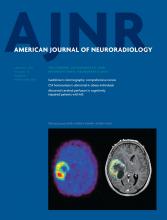Abstract
BACKGROUND AND PURPOSE: Hypoxic tissue evaluation in glioma is important for predicting treatment response and establishing antihypoxia therapy. In this preliminary study, 62Cu-ATSM PET was used to determine its validity as a biomarker for distinguishing tumor grade and tissue hypoxia.
MATERIALS AND METHODS: 62Cu-ATSM PET was performed in 22 patients with glioma, and the 62Cu-ATSM SUVmax and T/B ratio were semiquantitatively evaluated. 62Cu-ATSM uptake distribution was qualitatively evaluated and compared with MR imaging findings. HIF-1α expression, a hypoxia marker, was compared with 62Cu-ATSM uptake values.
RESULTS: The 62Cu-ATSM SUVmax and T/B ratio were significantly higher in grade IV than in grade III gliomas (P = .014 and .018, respectively), whereas no significant differences were found between grade III and grade II gliomas. At a T/B ratio cutoff threshold of 1.8, 62Cu-ATSM uptake was predictive of HIF-1α expression, with 92.3% sensitivity and 88.9% specificity. The mean T/B ratio was also significantly higher in HIF-1α-positive glioma tissue than in HIF-1α-negative tissue (P = .001). Using this optimal threshold of T/B ratio, 62Cu-ATSM PET showed regional uptake in 61.9% (13/21) of tumors within the contrast-enhanced region on MR imaging, which was significantly correlated with presence of a necrotic component (P = .002).
CONCLUSIONS: Our results demonstrated that 62Cu-ATSM uptake is relatively high in grade IV gliomas and correlates with the MR imaging findings of necrosis. Moreover, the 62Cu-ATSM T/B ratio showed significant correlation with HIF-1α expression. Thus, 62Cu-ATSM appears to be a suitable biomarker for predicting highly malignant grades and tissue hypoxia in patients with glioma.
ABBREVIATIONS:
- 62Cu-ATSM
- 62Cu-diacetyl-bis (N4-methylthiosemicarbazone)
- 18F-FMISO
- 18F-fluoromisonidazole
- HIF-1α
- hypoxia-inducible factor-1α
- pO2
- partial pressure of oxygen
- ROC
- receiver operating characteristic
- SUV
- standard uptake value
- T/B ratio
- tumor/ background ratio
- WHO
- World Health Organization
- © 2013 by American Journal of Neuroradiology
Indicates open access to non-subscribers at www.ajnr.org












